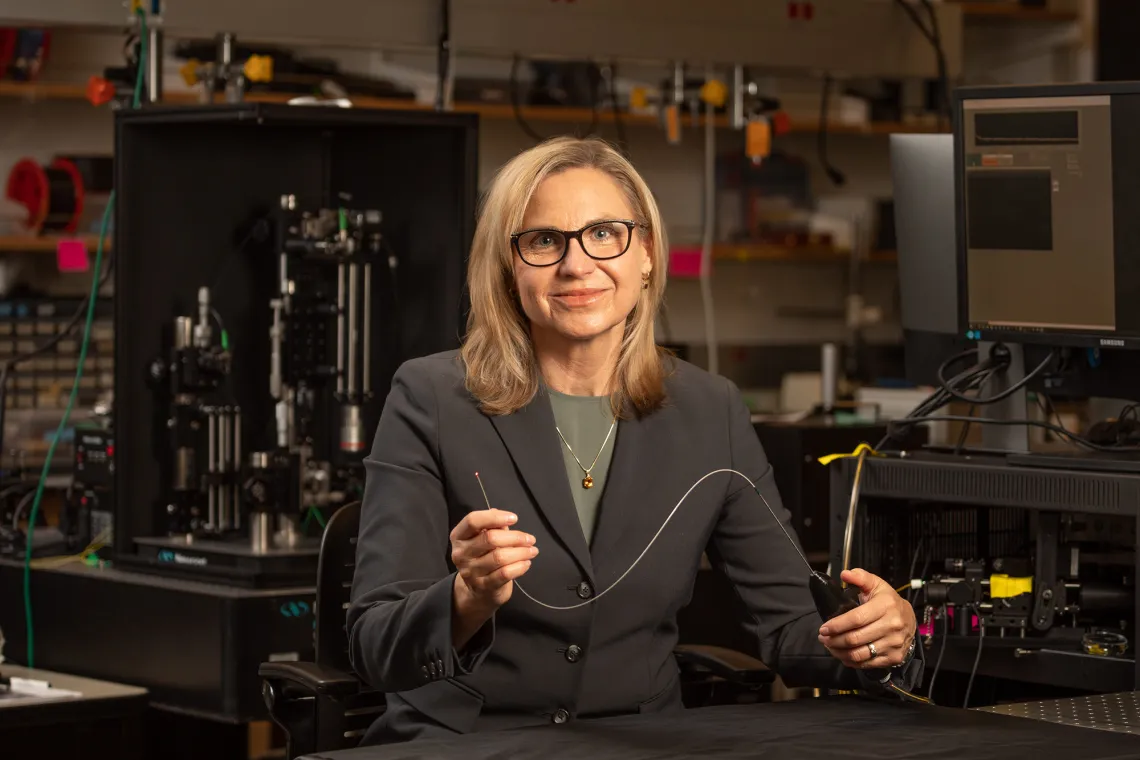Lifesaving Detection
Tiny device promises big strides for earlier ovarian cancer detection.

Due to a lack of effective screening and diagnostic tools, more than three-fourths of ovarian cancer cases are not found until the cancer is in an advanced stage. As a result, fewer than half of all women with ovarian cancer survive more than five years after diagnosis.
Jennifer Barton, director of the University of Arizona’s BIO5 Institute and the Thomas R. Brown Distinguished Chair in Biomedical Engineering, has spent years developing a device small enough to image the Fallopian tubes — narrow ducts connecting the uterus to the ovaries — to search for signs of early-stage cancer. Banner – University Medical Center surgeon John Heusinkveld has now used the new imaging device in study participants for the first time, as part of a pilot human trial.
Heusinkveld is using the falloposcope device to image the Fallopian tubes of volunteers who are already having their tubes removed for reasons other than cancer. This will allow researchers not only to test the effectiveness of the device but also to establish a baseline range of what normal Fallopian tubes should look like. Since September 2021, Heusinkveld has successfully used the falloposcope in four volunteers.
At 0.8 millimeters in diameter, the falloposcope’s small size and high resolution are unprecedented.
“It’s itty bitty,” says Barton, who also holds appointments in optical sciences and medical imaging and is a member of the UArizona Cancer Center. “You just couldn’t have fabricated something like this even six, seven years ago.”
Saving Many Lives, Improving Others
This year, about 19,880 women in the United States will receive a diagnosis of ovarian cancer, and approximately 12,810 will die from the disease, according to the American Cancer Society. Barton hopes her falloposcope will help save the lives of some women and vastly improve quality of life for others.
With better early-stage detection, women would be able to make more informed decisions about preventive surgeries. Because researchers believe ovarian cancer usually starts in the Fallopian tubes, many physicians recommend that women at risk for ovarian cancer have their ovaries and Fallopian tubes removed. Many women opt for the surgery because of its potentially lifesaving benefits, but it thrusts women into surgically induced menopause, with side effects including hot flashes, mood swings, and higher risk of heart and bone disease.
Barton cites one example of a study in which 122 patients who were known carriers of genes that increased their risk for cancer had their Fallopian tubes removed as a precaution. Analysis of the tubes after removal showed that only seven of the women were in the process of developing cancer.
“This device could allow us to tell those other 115 women, ‘Hey, you are perfectly normal, and we’ll come back and check on you every couple of years to make sure everything is OK,’” Barton explains.
Regular falloposcope screenings could mean that even patients who do ultimately opt for the removal procedure could do it later in life — for example, after childbearing years.
In the initial study, the research team hopes to image 20 sets of Fallopian tubes before removal. As the surgeon, Heusinkveld will provide feedback to the engineering team about how to make the device easier to use and more effective.
The work to develop a clinical translation of the device has been funded by the U.S. Army since 2018. Barton also is working with Tech Launch Arizona, the UArizona office that commercializes inventions stemming from university research, on strategies to bring it to the marketplace. TLA has filed three patents for technologies behind the device.
While it will likely be several years before the device is FDA approved, manufactured and available on the market, this milestone represents a critical step forward in a decade-long process — and could ultimately change ovarian cancer screening protocols forever.
Learn more about this life-saving device in this video.
